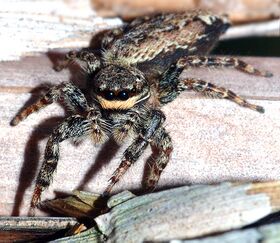Biology:Dionycha
| Dionycha | |
|---|---|

| |
| Marpissa muscosa | |
| Scientific classification | |
| Domain: | Eukaryota |
| Kingdom: | Animalia |
| Phylum: | Arthropoda |
| Subphylum: | Chelicerata |
| Class: | Arachnida |
| Order: | Araneae |
| Infraorder: | Araneomorphae |
| Clade: | Entelegynae |
| Clade: | Dionycha |
| Diversity[1] | |
| About 20 families | |
The Dionycha are a clade of spiders (Araneomorphae:Entelegynae), characterized by the possession of two tarsal claws with tufts of hairs (setae) beside them, which produce strong adhesion, enabling some species to climb glass.[2] The circumscription of the group has varied widely; a 2021 analysis resulted in about 20 families, including Salticidae (jumping spiders), Gnaphosidae (ground spiders), and Clubionidae.[3]
The Dionycha are considered to be a subgroup of the larger RTA clade.[2] Most species hunt their prey instead of building webs.
There are no cribellate members in the Dionycha.[4]
Today it is thought that the reduction of the third claw present in ancestral spiders evolved several times independently,[1] so this alone is not a criterion that defines the clade.
Families
In 2021, a group of several spider taxonomists published a major study of the phylogeny of Dionycha, using genetic and phenotypic data. It included the families listed below:[3]
- Dionycha
- Prodidomidae
- Dionycha A clade
- Dionycha B clade
Footnotes
- ↑ 1.0 1.1 Ramírez (2014).
- ↑ 2.0 2.1 Garrison, Nicole L.; Rodriguez, Juanita; Agnarsson, Ingi; Coddington, Jonathan A.; Griswold, Charles E.; Hamilton, Christopher A.; Hedin, Marshal; Kocot, Kevin M. et al. (2015). "Spider phylogenomics: untangling the Spider Tree of Life". PeerJ 3: e1852. doi:10.7717/peerj.1719. PMID 26925338.
- ↑ 3.0 3.1 Azevedo, Guilherme H. F.; Bougie, Tierney; Carboni, Martin; Hedin, Marshal; Ramírez, Martín J. (January 2022). "Combining genomic, phenotypic and Sanger sequencing data to elucidate the phylogeny of the two-clawed spiders (Dionycha)". Molecular Phylogenetics and Evolution 166: 107327. doi:10.1016/j.ympev.2021.107327. PMID 34666169.
- ↑ Griswold et al. 1999
References
- Bosselaers, J.; Jocqué, R. (2002). "Studies in Corinnidae: cladistic analysis of 38 corinnid and liocranid genera, and transfer of Phrurolithinae". Zoologica Scripta 31 (3): 241–270. doi:10.1046/j.1463-6409.2002.00080.x.
- Coddington, J. A.; Levi, H. W. (1991). "Systematics and evolution of spiders (Araneae)". Annual Review of Ecology and Systematics 22: 565–592. doi:10.1146/annurev.es.22.110191.003025.
- Griswold, C.E.; Coddington, J.A.; Platnick, N.I.; Forster, R.R. (1999). "Towards a Phylogeny of Entelegyne Spiders (Araneae, Araneomorphae, Entelegynae)". Journal of Arachnology 27: 53–63. http://www.americanarachnology.org/JoA_Congress/JoA_v27_n1/arac_27_01_0053.pdf.
- Ramírez, M. (2014). The morphology and phylogeny of Dionychan spiders (Araneae: Araneomorphae). Bulletin of the American Museum of Natural History. http://digitallibrary.amnh.org/handle/2246/6537. Retrieved 2015-10-31.
External links
Wikidata ☰ Q1226966 entry
 |

